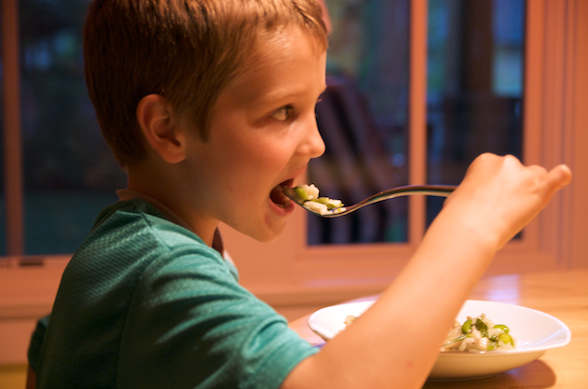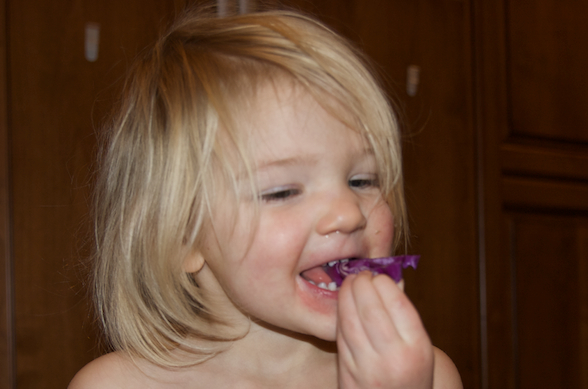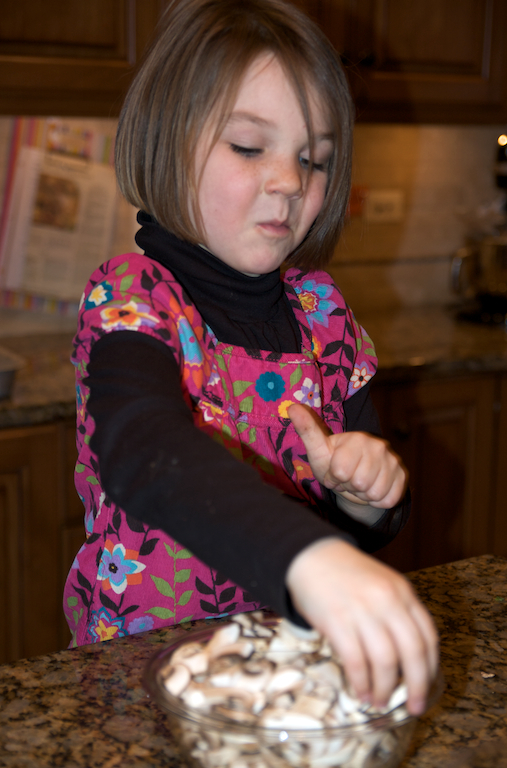Tastes Change

I'm often asked, "Do your kids actually eat that?" Yup. I shot this image of Penelope after she wolfed down her plate of Kaddo Borani. The expectation of constant variety I've created in my kids means that they have very little anxiety about trying new foods and can simply appreciate each dish for what it is.
A couple of weeks ago I had a speaking gig with a crowd of moms with very young children. Inevitably, I spent a large portion of my allocated speaking time advocating an approach to eating that can be summed up in one word: variety. I believe this is our number one goal in educating our children about food and its importance to their bodies. We must be as committed to teaching our children to accept variety and the unfamiliar as we are to getting them to read and share their toys. I’ll elaborate on this in a future post.
I got a number of questions during the Q&A time, but the underlying theme was the mothers’ predictable anxiety that there is something abusive about compelling their children to eat foods with which they are at best uncomfortable and at worst don’t “like.” I tried to assure them and talked at length about the importance of repeat exposures and expectations. Most “pickiness” is really more about a food anxiety than it is about actual preferences.
That evening, I was sitting with my two oldest kids at their piano lesson. Feeling a bit disinterested in listening to them do their scales, I decided to see what the NY Times had published in the week’s food section. Much to my amusement, Harold McGee- a favorite writer of mine who focuses on food science- wrote in his column, “The Curious Cook,” about the science of the polarity of opinion about cilantro. Cilantro is generally beloved or reviled. There are very few folks in the middle.
My irrepressible laugh interrupted the lesson when I read the following, “
…every new experience causes the brain to update and enlarge its set of patterns, and this can lead to a shift in how we perceive a food.
“I didn’t like cilantro to begin with,” he [Jay Gottfried, Northwestern University neuroscientist] said. “But I love food, and I ate all kinds of things, and I kept encountering it. My brain must have developed new patterns for cilantro flavor from those experiences, which included pleasure from the other flavors and the sharing with friends and family. That’s how people in cilantro-eating countries experience it every day.”
“So I began to like cilantro,” he said. “It can still remind me of soap, but it’s not threatening anymore, so that association fades into the background, and I enjoy its other qualities. On the other hand, if I ate cilantro once and never willingly let it pass my lips again, there wouldn’t have been a chance to reshape that perception.”
Of course. Doesn’t every adult have the experience of learning to enjoy a food that they used to abhor? Why do we doubt that our children are any less capable of forming new impressions of food? Why do parents seem to think that taste is so inflexible? Johnny likes chicken nuggets and hates carrots and that is the way it will always be. Really?

Max has always been very sensitive to food texture and has been pretty anxious about new foods. He's the typical kid who will always prefer pizza and french fries. With a lot of patience and commitment over the past 3 years, he now eats everything with minimal fuss.
I was trying to think of the best examples of the malleability of taste in my own life and was completely overwhelmed by how many of them there are. Growing up in the Midwest, I was never exposed to fresh fish. I usually experienced fish as canned tuna (the smell of which is still gag-inducing) or frozen fish fillets. Oddly enough, because my dad worked with a Japanese company, I learned to like sushi as a young teen because I frequently participated in work events where it was served. It wasn’t until I was an adult living on the coast that I learned to enjoy cooked fish- starting with experiences in fine restaurants.
This past weekend, my husband and I had our first weekend away in about 18 months. We went into the city and stayed at a swanky hotel on Michigan Ave. I took the train in and met him at the office. When I suggested sushi for dinner he didn’t blink. Really? This from a guy who wouldn’t even have thought about consuming any fish much less raw fish when I first met him 16 years ago. Oh yeah, he’s in a really good mood because he’s gonna get a lot of other stuff he’s wanting this weekend. After all, happily married people don’t get away from the kids just so they can read books and talk. So sushi it was.
The hotel concierge recommended a sushi place. We ordered a conciliatory chicken teriyaki and then, with a bit of cajoling on my part, we each ordered a sushi roll: I found something for Bill that didn’t actually have any raw fish in it. It did, however, have a dollop of masago on it when it arrived. Masago are flying fish roe. They are teeny-tiny and brilliant red in color. Their flavor is very subtle. I saw the look of revulsion on his face when I told him what it was. I could see that he wanted to freak out. “Now wait,” I said, “Stop thinking about what it is. Look at that. Look at how gorgeous they are. Seriously, really look at that.”
“They really are,” he said. After a moment of study, he tried a piece. “That’s pretty good.” Emboldened, he tried a piece of my roll, which did contain raw fish. Though he liked his roll well enough, he actually preferred mine. I suspect I might be able to get him to dine on sushi again without the promise of hotel sex next time. He formed a new impression of it. It is less scary than it used to be.
One of the most interesting books I’ve ever read on child development is a book called What’s Going on in There?, by Lise Eliot. The book is really about neuroplasticity from conception to the age of five. [Yeah, I actually am that nerdy.] Neuroplasticity is the way that the brain is constantly changing and updating itself- forming new connections and associations. In the chapter on taste, Lise explains:
Taste preferences are remarkably malleable. Although we are innately programmed to like sweet and salt, virtually every other aspect of food preference appears to be a product of experience, or an “acquired taste.” Genes play very little role in taste preference, based on the observation that identical twins are no more likely to prefer the same flavors than fraternal twins. Nurture, rather than nature, clearly dominates when it comes to our choice of foods and decisions about what we do and don’t like to eat.
If food preference is largely a product of experience, it is not surprising that this learning may be most potent in early childhood. Rats who have been exposed at an early age to a variety of flavors in their diet are likelier later in life to ingest a novel flavor- chocolate- than rats reared on a more restricted diet… Early exposure to a variety of flavors seems to reduce the fear of novel foods that is innate in rats, as in people. This preference for familiar foods is especially strong in young children, but by the same token, even two-year-olds can cultivate a taste for novel flavors, like exotic fruits and cheeses, if repeatedly exposed to them over the course of several weeks. Toddlers may go from actively spitting out a food that they’re tasting for the first time to clearly preferring it after several tries.

Its funny, but when I'm prepping vegetables at dinnertime, the kids are so curious and eager to try everything. Were I to put raw red cabbage on a plate next to a PBJ for lunch, however, they'd look at me like I'm crazy and wouldn't touch it. I don't care. Every time they try new foods they form another positive impression of that food being imprinted on their little brains that will shape healthy eating habits in the future.
So here’s the bottom line: taste is something that is developed over time through experience- a bit like character. You needn’t fret that your child’s rejection of rutabagas means that he doesn’t like them. They’re just too novel for him to accept yet. Even if he only ate three bites, the exposure in and of itself is important.
Every parent has had the experience of seeing one of their children suddenly reject a food that they’ve previously enjoyed. My eight-year-old suddenly got off of chicken last year. My two-year-old is anti-meat these days. Actually, just tonight she was gobbling fist-fulls of raw fresh fava beans while I was preparing them. I had to move the bowl to the other end of the island so that we’d have any to add to our risotto. But when they were in the risotto at the dinner table- hell no! She wasn’t about to touch them. When I hand-fed her one, she spit it out. I suspect she feels less control over what she eats when we’re sitting down to dinner than when she’s foraging through my prep bowls.
What my children know is that variety is a constant around here. I rarely make the same dish twice. We eat asparagus only in the spring. After a winter of eating lots of cabbage and hard squash, asparagus is a novelty again. Its okay if it takes them a while to enjoy it again.
Given the chance, your children will learn to adore fresh produce. I mean it. You just have to commit. And you just have to remember that their tears and gagging and anxiety aren’t permanent. This is all part of the process of developing their tastes. Do you feel guilty when your kid throws a breath-holding, face-reddening, “you-don’t-love-me” sort of hissy fit during a time out for spitting on her brother? I hope not! Should you be concerned that it is difficult for your child to eat three bites of fish? Be calm and just remember that you are parenting.

Sally was helping me prep mushrooms. She tried one raw and made a bit of a face. She wasn't sure if she liked it, so she tried it again. "Kinda good," she decided.
When I first started making my kids eat three bites of each food at dinner, my then four-year-old, Max, was very overwhelmed. There was gagging. There was vomiting. There were epic spells at the dinner table- he couldn’t be excused until his minimum portion was gone.
In a gesture of solidarity, I challenged myself to take on the food that most repulsed me: salad. My friends joke that my mother must have beat me with a head of Iceberg when I was a kid. I just HATED salad and everything associated with it: raw tomatoes, vinegar, mayonnaise. So I went to my very favorite local restaurant, Vie, and ordered a salad with a vinaigrette (vinegar is less scary to me than mayo- the very sight of which is nauseating to me). Though I struggled with the texture, the taste was really quite nice. My brain, however, kept screaming at me, “Oh no! You’re eating a salad. You don’t like salad. Stop!” I had to work to overcome these competing impulses.
Every time I was offered a decent salad from then on, I took three bites. I can honestly say that I can now enjoy- and occasionally crave- a simple salad.
So give your kids some credit. Give them the chance to enjoy the nutritional advantages that accrue from ingesting nature’s bounty. And if you’re feeling guilty, take on a food that you have a hard time with yourself.
Eat with courage.
Share your story of learning to love a food that you used to hate- or thought you hated. I’d love to hear it.



